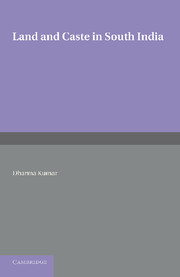 Land and Caste in South India
Land and Caste in South India Book contents
- Frontmatter
- Dedication
- CONTENTS
- List of Tables and Figures
- Acknowledgements and A Note on Certain Connventions
- Abbreviations
- Map of the Madras Presidency
- PART I
- PART II
- VII LAND AND POPULATION
- VIII EMIGRATION
- IX WAGES
- X THE GROWTH OF AGRICULTURAL LABOUR FROM 1871 TO 1901
- XI CONCLUSION
- Glossary
- Bibliography
- Index
XI - CONCLUSION
from PART II
Published online by Cambridge University Press: 05 June 2016
- Frontmatter
- Dedication
- CONTENTS
- List of Tables and Figures
- Acknowledgements and A Note on Certain Connventions
- Abbreviations
- Map of the Madras Presidency
- PART I
- PART II
- VII LAND AND POPULATION
- VIII EMIGRATION
- IX WAGES
- X THE GROWTH OF AGRICULTURAL LABOUR FROM 1871 TO 1901
- XI CONCLUSION
- Glossary
- Bibliography
- Index
Summary
The lack of data on the numbers of agricultural labourers in India before the era of the all-India Censuses has encouraged the belief that this class was small in size on the eve of British rule. And this assumption is connected with the belief that before the British seized power the typical Indian village was composed in the main of small peasants tilling their own land. Thus:
…there is a consensus of opinion that in pre-nineteenth-century India, there was no noticeably large class of agricultural labourers…. That in the course of about a hundred years, the whole social basis of a traditional society which had outlived so many previous invaders, could be so completely smashed by a handful of adventurers from an island in the far-off Atlantic and by a few of their native allies, in a country divided from the place of their birth by half the globe; that of its cultivators and artisans one-third could be turned into landless labourers and one-half into petty cultivators, tenants-at-will and share-croppers, are accomplishments for which one would look in vain for a parallel in the whole history of mankind.
This is the picture of the self-sufficient village first drawn by Metcalfe and Maine, and then taken over by Marx, who went on to show that the destruction of this system—a destruction he regarded as necessary—had been brought about by British imperialism. ‘England has broken down the whole framework of Indian society without any symptoms of reconstruction yet appearing.’ Marx's assumptions that native institutions could not survive the coming of the British, and that none of the changes in them had been self-generated, were shared by the imperialists themselves, who justified their rule by claiming to be the active agents of change in stagnant societies. But Marx's picture of the stagnant village community has been touched up and transformed into this idyllic view:
The village community was mainly composed of peasants. The village committee, representing the village community which was the de facto owner of the village land, distributed this land among the peasant families in the form of holdings. Each holding was cultivated by the collective labour of its members. …The peasant family enjoyed a traditional right to possess and cultivate its holding from generation to generation.
- Type
- Chapter
- Information
- Land and Caste in South IndiaAgricultural Labour in the Madras Presidency during the Nineteenth Century, pp. 186 - 193Publisher: Cambridge University PressPrint publication year: 2013


